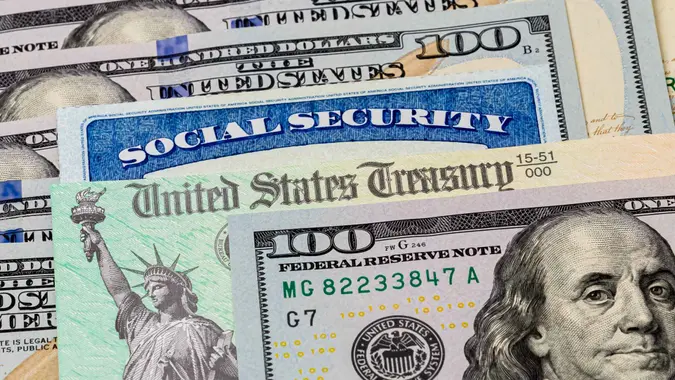This Is How Much an Upper-Class Retiree Takes Home From Social Security

Commitment to Our Readers
GOBankingRates' editorial team is committed to bringing you unbiased reviews and information. We use data-driven methodologies to evaluate financial products and services - our reviews and ratings are not influenced by advertisers. You can read more about our editorial guidelines and our products and services review methodology.

20 Years
Helping You Live Richer

Reviewed
by Experts

Trusted by
Millions of Readers
Social Security has been one of the most beloved social programs in the history of the United States. As originally designed, the system was bulletproof, with existing workers funding benefits for retirees through payroll taxes.
Unfortunately, a combination of factors has upset the balance that has kept Social Security solvent all these years. Demographics have played a big role, as the number of retirees relative to active workers has greatly increased, in part due to increasing longevity. As a result, the Social Security Trustees have said that, without legislative action, benefits could be cut by 23% as early as 2034.
For those in the upper-income brackets, this shouldn’t be as damaging as it would be to those in the lowest bracket, many of whom rely on Social Security as their only source of retirement income. But it still could sting, as those who earned more in their working careers also stand to lose more in terms of absolute dollars, as their Social Security payments are correspondingly higher, as well.
Here’s a look at income levels of the upper class, how they relate to Social Security and how big the average check is for an upper-class retiree.
Here are 6 social security changes coming in 2024.
Upper-Class Income Range for 2024
According to the Pew Research Center, “upper income” begins at double the national median income. As of March 2024, estimates for the median national income were at $95,750, putting “upper income” at $143,600 and above.
Average Social Security Check
The average retiree received a monthly Social Security check of $1,907 as of January 2024. Spousal benefits for those who weren’t drawing checks based on their own income averaged a monthly payment of $912.
If you combine these two benefits, it translates to the average worker and spouse household earning checks totaling $2,919 per month or $33,828 per year.
Average Social Security Checks of Upper-Class Retirees
The Social Security wage base is the maximum amount that you could earn and get credit for your future benefit checks. Generally speaking, upper-class workers earn above this limit. But for 2024, they may fall below this limit. For example, the Social Security wage base in 2024 is $168,600, above the Pew Research “upper income” level of $143,600 and above.
If upper-class workers earned above this limit for at least 35 years of their working careers, they would earn the maximum possible Social Security benefit.
The exact amount of the maximum Social Security benefit depends on the age at which age you file. This amount also changes from year to year. For example, those who filed for benefits at age 62 in 2024 could receive a maximum possible benefit of $2,710, while those who waited for “full retirement age” of 67 could draw as much as $3,822. Those who delayed filing until age 70 could snag the top possible retirement benefit of $4,873.
Ways To Boost Your Social Security Check
As noted above, the two factors that determine the size of your Social Security check are the age at which you file and how much you earn during the 35 top-earning years of your career.
To earn the maximum possible Social Security benefit, you’ll have to meet or exceed the Social Security wage base in each of those 35 years, and then delay filing until age 70.
Even for upper-class earners, a $4,873 monthly benefit, equating to $58,476 per year, is a substantial chunk of change. If those benefits were to be cut 23% in 2034, as is currently a possibility, that would amount to a yearly reduction of $13,449, or over $1,100 per month.
Additional Sources of Retirement Income for Upper-Class Retirees
Although most Americans likely would be quite happy with an annual Social Security benefit in excess of $50,000, that would just be a minority percentage of the retirement income for most upper-income Americans. Data from Vanguard shows that the average 401(k) balance for those with incomes of $150,000 and higher in 2021 was $354,569, vs. just $8,260 for those with incomes of $15,000 or less.
But high Social Security payments and large 401(k) balances are not the only sources of income that upper-class retirees can generally access. Rental properties, second homes, outside savings and retirement accounts and other assets help contribute to the minimum $2.2 million net worth that the 2023 Schwab Modern Wealth Survey says defines wealthy individuals.
In an imaginary scenario, if that $2.2 million net worth were completely liquid, it could generate $110,000 of income at just a 5% annual interest rate.
More From GOBankingRates
- Nearly 1 in 3 Americans Hit by a Costly Holiday Scam, Norton Survey Shows -- How To Avoid This
- Here's What Retirees Wasted the Most Money On in 2025 -- and How To Avoid It in 2026
- How Middle-Class Earners Are Quietly Becoming Millionaires -- and How You Can, Too
- 6 Safe Accounts Proven to Grow Your Money Up to 13x Faster
 Written by
Written by  Edited by
Edited by 

























